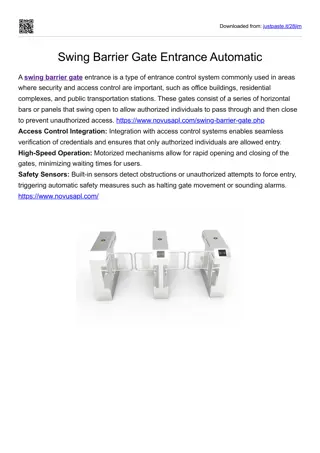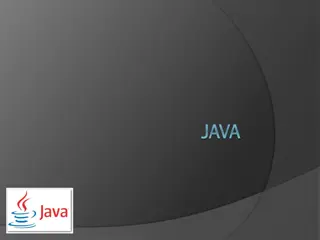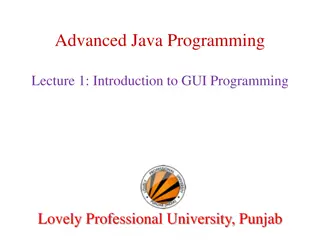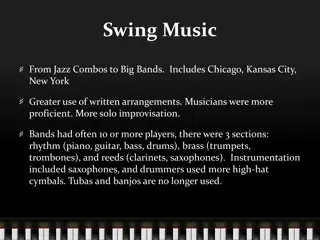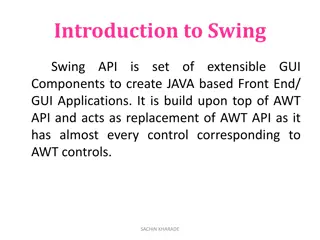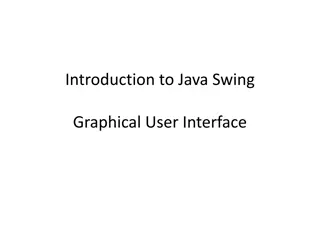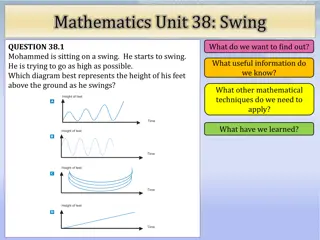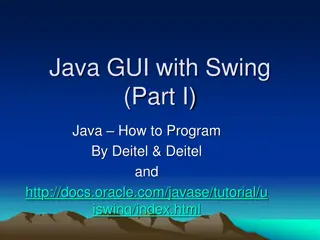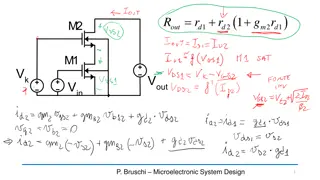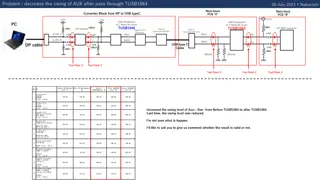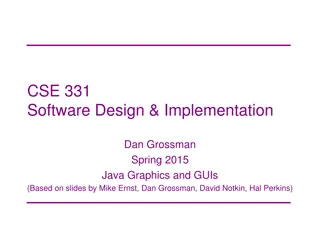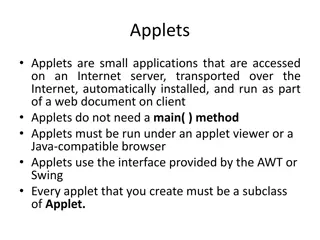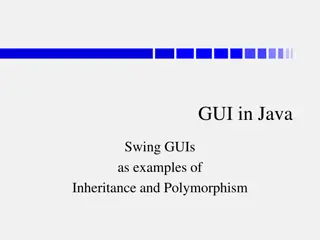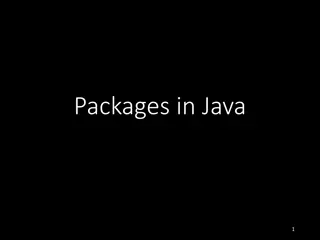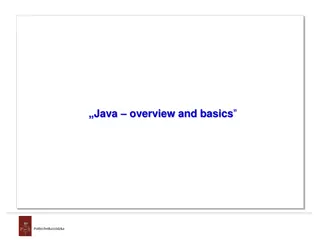
Event Handling in Java
Explore the basics of event handling in Java, including concepts, process setup, and examples like ActionListener interface implementation. Learn how events drive GUI interactions and how to create event handlers to respond effectively.
Download Presentation

Please find below an Image/Link to download the presentation.
The content on the website is provided AS IS for your information and personal use only. It may not be sold, licensed, or shared on other websites without obtaining consent from the author. If you encounter any issues during the download, it is possible that the publisher has removed the file from their server.
You are allowed to download the files provided on this website for personal or commercial use, subject to the condition that they are used lawfully. All files are the property of their respective owners.
The content on the website is provided AS IS for your information and personal use only. It may not be sold, licensed, or shared on other websites without obtaining consent from the author.
E N D
Presentation Transcript
Introduction to Event Handling
interface Subject interface Observer registerObserver() removeObserver() notifyObserver() update() ConcreteSubject ConcreteObserver registerObserver(){ } removeObserver(){ } notifyObserver(){ } update(){ } // other methods getState() setState()
Java Event Handling Example Name in Design Pattern Subject Observer ConcreteObserver Actual Name in JButton Event Handling JButton ActionListener The class that implements ActionListener interface addActionListener actionPerformed Attach() Notify()
Basic concepts Event When users interact with a GUI component, the interaction is called event Events drive the program to perform a task Event source the GUI component on which the event occurs Event handler (listener) The code that performs a task in response to an event Event set up The process of creating event handler class/object and registering the handler with event source Event handling The overall process of setting up event handling and responding to events
Event handling process Event set up Programmer write code to implement the event handler and register the event handler with a GUI component Event handling Java VM and GUI component works together responding to events
Set up Event Handling 1. Create an event handler (listener) class - The event handler class implements an appropriate event-listener interface. 2. Create an object of the above event handler class 3. Registering the event handler object with the event source (GUI component) i.e., when event occurs, a registered object of the event handler class will be notified.
Event handler Interface (ActionListener) Event Type (ActionEvent) GUI object (plainJButton=new JButton();) Class ButtonHandler implements ActionListener{ . Public void actionPerformed( ){ } . } Event handler class listenerList Event handler object handler = new ButtonHandler(); plainJButton.addActionListener (handler); Add handler object to the event listener list of GUI object
Event Handling (delegation event model) 1. When an event occurs, Java VM sent event object to GUI component 2. The event object contains - event source, event type, and event id, etc 3. When GUI component receives event object Identify the registered handler based on event type Identify the specific method for the registered handler based on event id Call the specific method to handle the event
Event Types & Listener Interfaces Many different types of events They are specified in java.awt.event Event types specific to Swing are specified in javax.swing.event For each event type, there is one or more corresponding event-listener interface For each listener interface, there is one or more event handling methods.
Action Event and Action Listener You implement an action listener to define what should be done when an user performs certain operation. An action event occurs, whenever an action is performed by the user. - clicks a button, - chooses a menu item, - presses Enter in a text field. When an action event occurs, JMV sends an ActionEvent class object to event source.
ActionEvent Class String getActionCommand() Returns the string associated with this action. Most objects that can fire action events support a method called setActionCommand that lets you set this string. int getModifiers() Returns an integer representing the modifier keys the user was pressing when the action event occurred. You can use the ActionEvent-defined constants SHIFT_MASK, CTRL_MASK, META_MASK, and ALT_MASK to determine which keys were pressed. For example, if the user Shift-selects a menu item, then the following expression is nonzero: actionEvent.getModifiers() & ActionEvent.SHIFT_MASK Object getSource() (in java.util.EventObject) Returns the object that fires the event.
ActionListener Interface public void actionPerformed(ActionEvent e) { ... //code that reacts to the action... }
Write an Action Listener: Declare an event handler class class either implements an ActionListener interface or extends a class that implements an ActionListener interface. public class MyClass implements ActionListener { public void actionPerformed(ActionEvent e) { ... //code that reacts to the action... } } Register an instance of the event handler class on one or more components. someComponent.addActionListener(instanceOfMyClass);
Event handling with Nested Classes
// Fig. 11.9: TextFieldFrame.java // Demonstrating the JTextField class. import java.awt.FlowLayout; import java.awt.event.ActionListener; import java.awt.event.ActionEvent; import javax.swing.JFrame; import javax.swing.JTextField; import javax.swing.JPasswordField; import javax.swing.JOptionPane; public class TextFieldFrame extends JFrame { private JTextField textField1; // text field with set size private JTextField textField2; // text field constructed with text private JTextField textField3; // text field with text and size private JPasswordField passwordField; // password field with text
// TextFieldFrame constructor adds JTextFields to JFrame public TextFieldFrame() { super( "Testing JTextField and JPasswordField" ); setLayout( new FlowLayout() ); // set frame layout // construct textfield with 10 columns textField1 = new JTextField( 10 ); add( textField1 ); // add textField1 to JFrame // construct textfield with default text textField2 = new JTextField( "Enter text here" ); add( textField2 ); // add textField2 to JFrame // construct textfield with default text and 21 columns textField3 = new JTextField( "Uneditable text field", 21 ); textField3.setEditable( false ); // disable editing add( textField3 ); // add textField3 to JFrame // construct passwordfield with default text passwordField = new JPasswordField( "Hidden text" ); add(passwordField ); // add passwordField to JFrame
// create and register event handlers TextFieldHandler handler = new TextFieldHandler(); // create and register event handlers textField1.addActionListener( handler ); textField2.addActionListener( handler ); textField3.addActionListener( handler ); passwordField.addActionListener( handler ); } // end TextFieldFrame constructor
// private inner class for event handling private class TextFieldHandler implements ActionListener { // process textfield events public void actionPerformed( ActionEvent event ) { String string = ""; // declare string to display // user pressed Enter in JTextField textField1 if ( event.getSource() == textField1 ) string = String.format( "textField1: %s", event.getActionCommand() ); // user pressed Enter in JTextField textField2 else if ( event.getSource() == textField2 ) string = String.format( "textField2: %s", event.getActionCommand() ); // user pressed Enter in JTextField textField3 else if ( event.getSource() == textField3 ) string = String.format( "textField3: %s", event.getActionCommand() ); // user pressed Enter in JTextField passwordField else if ( event.getSource() == passwordField ) string = String.format( "passwordField: %s", new String( passwordField.getPassword() ) );
} // end class TextFieldFrame // Fig. 11.10: TextFieldTest.java // Testing TextFieldFrame. import javax.swing.JFrame; public class TextFieldTest { public static void main( String args[] ) { TextFieldFrame textFieldFrame = new TextFieldFrame(); textFieldFrame.setDefaultCloseOperation( JFrame.EXIT_ON_CLOSE ); textFieldFrame.setSize( 325, 100 ); // set frame size textFieldFrame.setVisible( true ); // display frame } // end main } // end class TextFieldTest
Event handling with Anonymous Inner Class
public class ButtonFrame extends JFrame { private JButton plainJButton; // button with just text // ButtonFrame adds JButtons to JFrame public ButtonFrame() { super( "Testing Buttons" ); setLayout( new FlowLayout() ); // set frame layout plainJButton = new JButton( "Plain Button" ); // button with text add( plainJButton ); // add plainJButton to JFrame // create new ButtonHandler for button event handling ButtonHandler handler = new ButtonHandler(); plainJButton.addActionListener( handler ); } // end ButtonFrame constructor // inner class for button event handling private class ButtonHandler implements ActionListener { // handle button event public void actionPerformed( ActionEvent event ) { JOptionPane.showMessageDialog( ButtonFrame.this, String.format( "You pressed: %s", event.getActionCommand() ) ); } // end method actionPerformed } // end private inner class ButtonHandler } // end class ButtonFrame
public class ButtonFrame extends JFrame { private JButton plainJButton; // button with just text // ButtonFrame adds JButtons to JFrame public ButtonFrame() { super( "Testing Buttons" ); setLayout( new FlowLayout() ); // set frame layout plainJButton = new JButton( "Plain Button" ); // button with text add( plainJButton ); // add plainJButton to JFrame //Use anonymous inner class plainJButton.addActionListener( new ActionListener () // anonymous inner class { // handle button event public void actionPerformed( ActionEvent event ) { JOptionPane.showMessageDialog( ButtonFrame.this, String.format("You pressed: %s", event.getActionCommand() ) ); } // end method actionPerformed } // end of anonymous inner class ); // end of add } // end ButtonFrame constructor } // end class ButtonFrame

